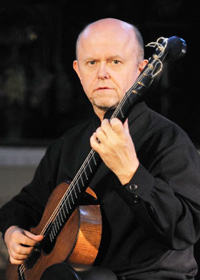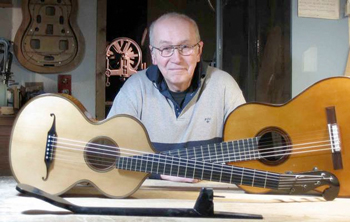By Daniel Hathaway and Mike Telin

Featured recitalists will include CIM’s own Jason Vieaux with soprano Jung Eun Oh; SoloDuo with Matteo Mela and Lorenzo Micheli (Italy); Gaëlle Solal (France); and Pavel Steidl (Czech Republic), and lectures will be given by Jonathan Fitzgerald (USA, “Listening and Re-listening: opening your ears to new sounds”); Alan Bise (Azica Records, Cleveland, “The Recording Process: from artistic vision to retail sale”); and Bernhard Kresse (Germany, “The Viennese 19th century Guitar Making Tradition”).
Although all the events center around the classical guitar, two are linked by a certain style of instrument. Pavel Steidl will play his Friday evening recital on a copy of a nineteenth-century Viennese instrument built by Bernhard Kresse. We spoke with Steidl via Skype in Mexico, where he was on tour, and with Kresse by phone in Köln, to learn more about the recital and this special instrument.
Pavel Steidl
“You can compare the period guitar from the nineteenth century and the modern guitar with the Hammerklavier and the modern Steinway”, Steidl told us. “The modern instrument is more resonant and seems to produce more sound, but the romantic instrument separates the voices more clearly and produces huge, rich colors. Maybe the sound seems smaller, but in my experience, the projection of the sound is very good”.
The guitar Steidl will use was built by Bernhard Kresse after an instrument made in Vienna by Johann Georg Stauffer in 1820. “My program is very much connected to the instrument I’m going to play. I’ll begin with a few pieces by the Viennese composer Johann Kaspar Mertz — very beautiful romantic music — then a set of original pieces by Niccolò Paganini. Paganini was one of the best guitarists of the period, but no one knew it, and his pieces have been neglected by guitarists for centuries. He was really something special. He had two faces. His public face was the devil of the violin, a big star like Michael Jackson or Elvis Presley. He didn’t want to show his lyric and poetic side, which was hidden in the guitar repertory.”
Steidl only seriously addressed himself to Paganini’s guitar music a decade ago when he was asked to record some of the repertory, but he wasn’t encouraged by what he saw in the scores. “Berlioz mentions in his memoirs that Paganini produced sounds on the guitar he had never heard before, but what Paganini left on paper doesn’t look like that: it looks very simple and easy. I said, ‘what do I have to do with this music?’ The producers said, ‘try!’”
Steidl applied himself to the task and began to appreciate what lay beneath the unpromising surface of the pieces. “Paganini wrote mostly two kinds of guitar pieces, ‘sonatas’ or two movement pieces combining a minuet with a waltz, adagio or andante, and ‘ghiribizzi’, a kind of idea or sketch drawing he did very fast like a child. It means that the musician is very free to do a lot of things with the music, depending on your taste and intuition and sense of fantasy.” Steidl will play eight of those little sonatas interleaved with a pair of ghiribizzi, and though he has recorded them, he’ll play some of the pieces for the first time in public in Cleveland.
His program will continue with the Bach Chaconne (“which can be very interesting to hear on an old instrument”), minuets by Fernando Sor (“jewels among his compositions”) and a Fantasie Caprice by Zani de Ferranti (“an unknown Italian composer who was a close friend of Paganini”).
Those who might not expect the guitar to be such a popular instrument in Czech culture are in for a surprise in chatting with Pavel Steidl. “Everybody connects the instrument with Spain, but in the nineteenth century, the guitar was very popular in Italy and Vienna. Prague is very close to Vienna and Viennese musicians came frequently to Prague where the guitar became an important classical and popular instrument. In the twentieth century, we watched Western movies and saw cowboys singing, and bluegrass became one of the most popular types of music in the Czech Republic”.
Bluegrass proved to be Steidl’s own entre into the guitar. “My brother, who is six years older, loved to play the banjo and as a younger brother, I had to play the guitar to accompany him”. Soon, Steidl was playing mandolin and joined a bluegrass group at the age of ten, where he found himself “singing a lot of songs about the Ohio River”. He entered a conservatory at sixteen when he was still unable to read music. “I could play what my teacher played back to him because I was used to playing by eye and ear. Now we have discovered that this is the best way to learn an instrument”.
Many years later, after studying with Milan Zelenka and Stephan Rak, and winning first prize at the Radio France International Competition in Paris in 1982, Pavel Steidl has established himself as a distinguished international artist as well as a composer. Will the Mixon Hall audience hear any of his own music on Friday evening? “Surprise!”, says Pavel Steidl. “We will see!”
Bernhard Kresse

Bernhard Kresse: I studied architecture, but then I stopped and began to make guitars. At first, just modern concert guitars, but then I came across the romantic guitar when customers began to bring them into my shop for some repairs and restoration. Then I went to Paris and London and bought some original romantic guitars, and yes, that’s how it started. It wasn’t until later that I began to make reproductions of instruments from that period.
Mike Telin: In North America we have been familiar with the guitar literature from the baroque and modern periods, but it has taken some time for the romantic literature to become common on recitals.
BK: Yes, and it was the same here. I remember going to festivals in the mid- and late 1980’s, and presented my romantic instruments and many people said, oh what’s this? Are these children’s guitars?
Also when I first became interested in this field, I would not have expected that there would be so many guitars from the romantic period that were still around. In the last ten years, I think it might be eBay that helped to bring all of these instruments to the surface.
MT: What attracted you to these instruments?
BK: When customers first started bringing them, I saw how well they were made, and the beautiful varnish, but mainly the way they sounded was amazing. The same kind of guitar was made at the beginning of the twentieth century, and although the dimensions are the same, they don’t sound as good as a French or Viennese guitar from the nineteenth century.
MT: Will you be talking about this at your lecture next week?
BK: Yes, I will be talking about the Viennese guitar. Pavel Steidl will also be there and he is one of my customers. But the Viennese guitars are my favorite, so I will talk about their development, technical details and the difference in sound from modern guitars. I will also talk about the possibilities these instruments have.
MT: How is the sound of a romantic Viennese guitar different from a modern instrument?
BK: First, the Viennese guitars are smaller, although they have the same acoustic energy as the modern instruments, but because of the smaller body, the enclosed air volume is smaller, the soundboard is smaller and so the instrument can react much faster. It’s like the difference between a limousine and a sports car with the same engine. So not only is there a quicker response, but more importantly, many of the guitar techniques like vibrato and glissandi are far easier to perform. And on the romantic guitar the audience can hear these things much easier. If you go to Pavel’s concert you will be able to hear what we call “fine articulation”.
MT: The literature from that period is also wonderful.
BK: Yes, but maybe not everything because during the first two or three decades of the nineteenth century they wrote a lot of music. Maybe not all of the literature is important, but there is a lot. I also think there is a lot of literature from that period that is yet to be discovered.
MT: How did your training as an architect help you when first started learning to make guitars?
BK: Oh, I never thought about this, [laughing], but maybe it’s the interest in creating, and all I did was switch to a smaller object. But I do remember that when I came to the guitar, and I made my first drawings of my own guitars, I did try to implement some of the rules of architecture when it came to things like proportions. But the romantic guitars were first made by violin makers, and so they paid attention to proportions far more then the makers of the Spanish guitars did, for example. I will also talk about this in my lecture.
MT: How did you come to meet Pavel Steidl?
BK: I think I met him in the early 1990’s and he asked me to build him a Viennese guitar. This was before I had become interested in those instruments but Pavel was a famous person, so I couldn’t say no. I did end up going to the museums in Nurnberg and Vienna to do research. But he is such a nice person and a great musician, and I look forward to seeing him in Cleveland.
Pavel Steidl plays the opening recital for Classical Guitar Weekend on Friday, June 1 at 8 pm in Mixon Hall at CIM (tickets required). Bernhardt Kresse’s lecture will take place on Saturday, June 2 at 9:30 am in CIM’s Studio 217 (free). Visit the Classical Guitar Weekend web site.
Published on ClevelandClassical.com May 29, 2012



